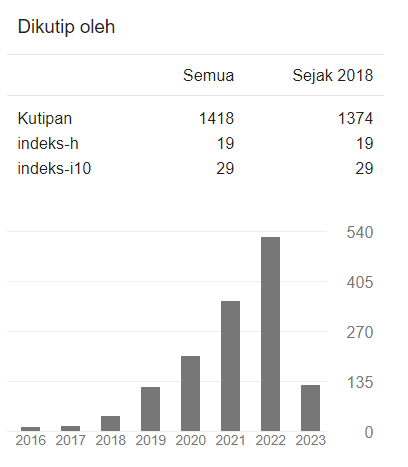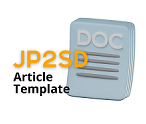Multimedia Interaktif Berbasis Articulate Storyline 3 Sebagai Alternatif Media Pembelajaran Materi Karakteristik Geografis Indonesia di Sekolah Dasar
DOI:
https://doi.org/10.22219/jp2sd.v11i1.22316Keywords:
Interactive Multimedia, Articulate Storyline 3, Geographical Characteristics of IndonesiaAbstract
The study was conducted based on observations at SDN Sukorame 2 Kediri, which showed that as many as 69.09% of students in Grade V on Indonesian geographical characteristics obtained scores below KKM (Minimum Criteria of Mastery Learning). This problem occurred because of the incompleteness of the material presented in learning resources and no learning media that could clearly describe the geographical characteristics of big islands in Indonesia. In addition, the information obtained that as many as 96.36% of students prefer digital-based learning resources equipped with writing, images, sound, and animation. However, SDN Sukorame 2 Kediri currently still lacked of digital-based learning resources. Based on problem analysis and needs analysis, researchers will develop interactive multimedia by utilizing Articulate Storyline 3 software. This research and development aim to produce innovation in learning activities to be more effective in the form of interactive multimedia that helps students understand the material and increase motivation in learning. This research uses the R&D method with the ADDIE model. The results of this study showed that the validity of material experts was 90% and media experts were 82%, so the average validation results were 86%. The practical results of the questionnaire of expert responses of limited-scale practitioners are 91% and broad-scale practitioner experts are 95%, so an average practical result of 93% is obtained. The results of effectiveness on a limited scale of 84 and extensive trials of 82 so that it is known that student learning outcomes after using interactive multimedia are higher than before the use of multimedia. Based on the data from the validity, practicality and effectiveness test results, it can be concluded that interactive multimedia by utilizing Articulate Storyline 3 is valid, practical and effective use.
Downloads
References
Darnawati, D., Jamiludin, J., Batia, L., Irawaty, I., & Salim, S. (2019). Pemberdayaan Guru Melalui Pengembangan Multimedia Pembelajaran Interaktif dengan Aplikasi Articulate Storyline. Amal Ilmiah : Jurnal Pengabdian Kepada Masyarakat, 1(1), 8-16. https://doi.org/10.36709/amalilmiah.v1i1.8780
Dwiqi, G. C. S., Sudatha, I. G. W., & Sukmana, A. I. W. I. Y. (2020). Pengembangan Multimedia Pembelajaran Interaktif Mata Pelajaran IPA Untuk Siswa SD Kelas V. Jurnal Edutech Undiksha, 8(2), 33. https://doi.org/10.23887/jeu.v8i2.28934
Febriandi, R. (2020). Efektivitas Multimedia Interaktif Terhadap Pembelajaran Matematika Siswa Kelas V SD Negeri 58 Lubuklinggau. Journal of Elemantary School (JOES), 3(2), 120-128. https://doi.org/10.31539/joes.v3i2.1897
Febrianti, E., Wahyuningtyas, N., & Ratnawati, N. (2021). Pengembangan aplikasi ARTS (Articulate Storyline) materi nilai-nilai budaya masa praaksara di Indonesia. Jurnal Inovasi Teknologi, 8(2), 209–219. https://journal.uny.ac.id/index.php/jitp/article/view/43111
Gafur, A. (2012). Desain Pembelajaran: Konsep, Model, dan Aplikasinya dalam Perencanaan Pelaksanaan Pembelajaran. Yogyakarta: Ombak.
Istiqlal, M. (2017). Pengembangan Multimedia Interaktif Dalam Pembelajaran Matematika. JIPMat, 2(1), 43-54. https://doi.org/10.26877/jipmat.v2i1.1480
Juhaeni, J., Safaruddin, S., & Salsabila, Z. P. (2021). Articulate Storyline sebagai Media Pembelajaran Interaktif untuk Peserta Didik Madrasah Ibtidaiyah. AULADUNA: Jurnal Pendidikan Dasar Islam, 8(2), 150-159. https://doi.org/10.24252/auladuna.v8i2a3.2021
Karo-Karo, I. R., & Rohani, R. (2018). Manfaat Media Dalam Pembelajaran. AXIOM : Jurnal Pendidikan Dan Matematika, 7(1), 91–96.
Leztiyani, I. (2021). Optimalisasi Penggunaan Articulate Storyline 3 dalam Pembelajaran Bahasa Dan Sastra Indonesia. Jurnal Pendidikan Indonesia, 2(1), 24–35. https://doi.org/10.36418/japendi.v2i1.63
Mahmud, N. F. (2020). Pengembangan Multimedia Interaktif Rumah Adat Nusantara (RAN) Menggunakan Articulate Storyline pada Mata Pelajaran IPS Kelas IV B SD Telkom Makassar. Universitas Negeri Makasar.
Manurung, P. (2021). Multimedia Interaktif sebagai Media Pembelajaran pada Masa Pandemi Covid-19. Al-Fikru: Jurnal Ilmiah, 14(1), 1–12. https://doi.org/10.51672/alfikru.v14i1.33
Munir. (2015). Multimedia: Konsep dan Aplikasi dalam Pendidikan. Bandung: Alfabeta.
Nugraheni, T. D. (2018). Pengembangan Media Pembelajaran Interaktif Menggunakan Articulate Storyline Pada Mata Pelajaran Sejarah Indonesia Kelas X Di Smk Negeri 1 Kebumen. Universitas Negeri Semarang
Nurrita, T. (2018). Pengembangan Media Pembelajaran untuk Meningkatkan Hasil Belajar Siswa. MISYKAT: Jurnal Ilmu-Ilmu Al-Quran, Hadist, Syari’ah Dan Tarbiyah, 3(1), 171-187. https://doi.org/10.33511/misykat.v3n1
Pakpahan, F. A. (2020). Pengembangan Media Pembelajaran. Medan: Yayasan Kita Menulis.
Piskurich, & M., G. (2000). The ASTD Handbook Of Training Design and Delivery. New York: McGraww-Hill.
Pratama, R. A. (2019). Media Pembelajaran Berbasis Articulate Storyline 2 pada Materi Menggambar Grafik Fungsi di SMP Patra Dharma 2 Balikpapan. Jurnal Dimensi, 7(1), 19-35. https://doi.org/10.33373/dms.v7i1.1631
Rayanto, Y. H., & Sugianti. (2020). Penelitian Pengembangan Model ADDIE dan R2D2: Teori & Praktek. Pasuruan: Lembaga Academic & Research.
Riduwan, & Akdon. (2013). Rumus dan Data dalam Analisis Statistika. Bandung: Alfabeta.
Safaruddin, Degeng, I. N. S., Setyosari, P., & Murtadho, N. (2020). The Effect Of PJBL With WBL Media And Cognitive Style On Students’ Understanding And Science-Integrated Concept Application. Jurnal Pendidikan IPA Indonesia, 9(3), 384–395. https://doi.org/10.15294/jpii.v9i3.24628
Safira, A. D., Sarifah, I., & Sekaringtyas, T. (2021). Pengembangan Media Pembelajaran Interaktif Berbasis Web Articulate Storyline pada Pembelajaran IPA di Kelas V Sekolah Dasar. Prima Magistra: Jurnal Ilmiah Kependidikan, 2(2), 237–253. https://doi.org/10.37478/jpm.v2i2.1109
Sam, N. (2021). Pengembangan Multimedia Pembelajaran pada Mata Pelajaran IPS di SMP Negeri 46 Makassar. Journal of Educational Technology, Curriculum, Learning, and Communication, 1(3), 138–148. https://doi.org/10.26858/jetclc.v1i3.21215
Sari, R. K., & Harjono, N. (2021). Pengembangan Media Pembelajaran Interaktif Berbasis Articulate Storyline Tematik terhadap Minat Belajar Siswa Kelas 4 SD. Jurnal Pedagogi dan Pembelajaran, 4(1), 122-130. https://doi.org/10.23887/jp2.v4i1.33356
Saski, N. H., & Sudarwanto, T. (2021). Kelayakan Media Pembelajaran Market Learning Berbasis Digital pada Mata Kuliah Strategi Pemasaran. Jurnal Pendidikan Tata Niaga (JPTN), 9(1), 1118–1124. Retrieved from https://ejournal.unesa.ac.id/index.php/jptn/article/view/40502
Septyanti, E., Kurniaman, O., & Charlina. (2020). Development Of Interactive Media Based On Adobe Flash In Listening Learning For University Student. International Journal of Scientific and Technology Research, 9(1), 74–77. https://www.ijstr.org/final-print/jan2020/Development-Of-Interactive-Media-Based-On-Adobe-Flash-In-Listening-Learning-For-University-Student.pdf
Sugiyono. (2016). Metode Penelitian Kuantitatif, Kualitatif, dan R&D. Bandung: Alfabeta, cv.
Tanjung, M. R., & Parsika, T. F. (2017). Pengembangan Aplikasi Multimedia Pengenalan dan Pembelajaran Origami dengan Pendekatan ADDIE. Seminar Nasional Informatika, 1(1), 128–133.
Telaumbanua, N. A., Lase, D., & Ndraha, A. (2021). Kreativitas Guru dalam Menggunakan Media Pembelajaran di SD Negeri 075082 Marafala. HINENI: Jurnal Ilmiah Mahasiswa, 1(1), 10–28. https://doi.org/10.36588/hjim.v1i1.63
Utami, Y. S., & Wahyudi. (2021). Pengembangan Media Interaktif Berbasis Articulate Storyline pada Pembelajaran Tematik Peserta Didik Kelas V SD. Jurnal Riset Pendidikan Dasar, 03(2), 62–71. https://doi.org/10.26618/jrpd.v4i1.5056
Widiara, I. K. (2020). Blended Learning sebagai Alternatif Pembelajaran di Era Digital. Jurnal Pendidikan, 2(2), 50–56.
Wijaya, K. A., Sapti, M., & Pangestika, R. R. (2022). Pengembangan E-Modul Bangun Datar Berbasis Teori Multiple Intelligence untuk Siswa Kelas IV SDN Ngupasan. Jurnal Pemikiran Dan Pengembangan Sekolah Dasar (JP2SD), 10(1), 96–103. https://ejournal.umm.ac.id/index.php/jp2sd/article/view/20249
Winda, R., & Dafit, F. (2021). Analisis Kesulitan Guru dalam Penggunaan Media Pembelajaran Online di Sekolah Dasar. Jurnal Pedagogi Dan Pembelajaran, 4(2), 211-221. https://doi.org/10.23887/jp2.v4i2.38941
Yuanta, F. (2020). Pengembangan Media Video Pembelajaran Ilmu Pengetahuan Sosial pada Siswa Sekolah Dasar. Trapsila: Jurnal Pendidikan Dasar, 1(02), 91. https://doi.org/10.30742/tpd.v1i02.816
Yumini, Siti & Rakhmawati, L. (2015). Pengembangan Media Pembelajaran Interaktif Berbasis Articulate Storyline pada Mata Diklat Teknik Elektronika Dasar di SMK Negeri 1 Jetis Mojokerto. Jurnal Pendidikan Teknik Elektro, 4(3), 845–849. http://ejournal.unesa.ac.id/index.php/jurnal-pendidikan-teknik-elektro/article/view/12673
Downloads
Published
Issue
Section
License
Copyright (c) 2023 Dwi Novia Rachmawati, Ita Kurnia , Alfi Laila

This work is licensed under a Creative Commons Attribution-ShareAlike 4.0 International License.
Authors who publish with Jurnal Pemikiran dan Pengembangan Sekolah Dasar (JP2SD) agree to the following terms:
- For all articles published in Jurnal Pemikiran dan Pengembangan Sekolah Dasar (JP2SD), copyright is retained by the authors. Authors give permission to the publisher to announce the work with conditions. When the manuscript is accepted for publication, the authors agree to automatic transfer of the publishing right to the publisher.
- Authors retain copyright and grant the journal right of first publication with the work simultaneously licensed under a Creative Commons Attribution-ShareAlike 4.0 International License that allows others to share the work with an acknowledgment of the work's authorship and initial publication in this journal.
- Authors are able to enter into separate, additional contractual arrangements for the non-exclusive distribution of the journal's published version of the work (e.g., post it to an institutional repository or publish it in a book), with an acknowledgment of its initial publication in this journal.
- Authors are permitted and encouraged to post their work online (e.g., in institutional repositories or on their website) prior to and during the submission process, as it can lead to productive exchanges, as well as earlier and greater citation of published work (See The Effect of Open Access).

This work is licensed under a Creative Commons Attribution-ShareAlike 4.0 International License.


















